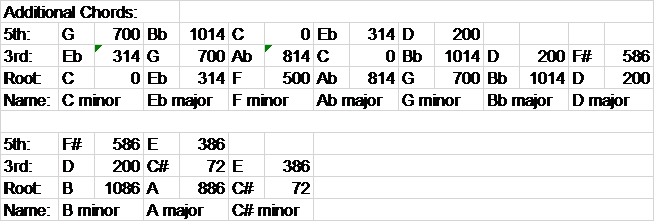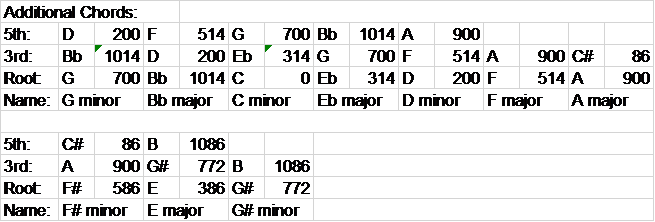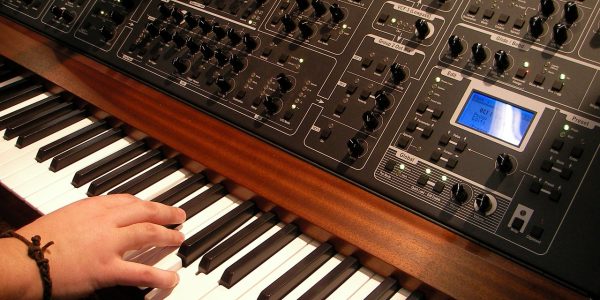Estimated reading time 7 minutes
Table of Contents
Introduction
Have You Tried Retuning Your Synth, But Gotten Frustrated by the Limited Number of Keys?
Do you want your keyboard’s chords to sound stronger when playing brass, string, and organ sounds? Supplemented Equal Temperament (SET) is a new and powerful tuning system that allows your chords to sound stronger and more in tune. Kurzweil’s PC3K synth also makes it a breeze to switch keys while using SET. (I get nothing from Kurzweil for saying this.) Read more to learn how to change keys in Supplemented Equal Temperament.
This sound track gives an example of how chords sound in SET. The synth on this track uses an organ sound, but brass, woodwind, and strings sound great too.
SET Organ:
How Can I Use Supplemented Equal Temperament?
There are many ways that changing keys in Supplemented Equal Temperament can be really useful in music. I’ll give you three examples:
- Do you play keyboard? Composing on the synth is the first, and most obvious, use for SET. However, it can be useful for much more than just synth music.
- Are you in a band? In the post, How to Get a Killer Sound for Your Band, we talked about how guitars and keyboards can be micro tuned. Then, we discussed how to combine them (along with a variety of other instruments) to create a SET tuned band. The present post allows you to use the concepts presented in Killer Sound while still giving you all 24 major and minor keys. For this we need the Tonality/Modality Chart (T/M Chart). In addition, Killer Sound shows how SET tuned guitars and synths tune in both similar and different ways.
- Do you conduct a choir? Choral directors will also find the ability to change keys of great value when working on harmonic intonation. Singing in Tune with Synth Settings discusses how chorus leaders can retune their synths to create harmonic sound models for their choirs. This gives you a powerful ear training tool that fosters barbershop level vocal tuning. The present post will then unlock the number of keys in which you can train.
Barbershop Quartet Video
How to Change Keys in Supplemented Equal Temperament: Reviewing How to Micro Tune the Synth
Before we can talk about changing keys in Supplemented Equal Temperament, we need to review tuning the synth. The following links come from the post How to Micro Tune the Keyboard to Make the Chords Sound Amazing.
- We talked about the basics of using cents in the section: Retuning the Keyboard Using Cents.
- However, not all synths have been designed to handle micro tuning. This section has some links that discuss microtonal capable synths: The Type of Keyboard Needed to Retune the Keys.
- We covered tuning using the synth’s global tuning parameter in this section: Retuning the Keyboard Using the Global Tuning Parameter.
C Tuning Template and How to Change Keys in Supplemented Equal Temperament
In the post, How Chords in Supplemented Equal Temperament Work we did not talk about changing keys in Supplemented Equal Temperament. However, some ability to change keys exists in the keyboard template mentioned in that post.
In other words, we had discussed chords that centered around the key of C major (see the keyboard template and chord analysis below). We’ll call this keyboard diagram the C Tuning Template. In the C Tuning Template, you will notice that other keys can be played. This means that while the template gets centered on C, it does not limit the keys to just C major.
Partial versions of G and D major, as well as A minor can be played using the C Tuning Template. How Chords in Supplemented Equal Temperament Work talks about this in detail.
What do you do if you want to play in more than just these four keys? We need some additional tools for this. Particularly, the PC3K synth makes the process much easier. Read more to find out how it does it.
Mobile users: for best results reading the examples, tilt your screen 90o to the right.
C Tuning Template



G Tuning Template and How to Change Keys in Supplemented Equal Temperament
As I already mentioned, changing keys in Supplemented Equal Temperament is really easy if you have a PC3K synth. Set up the global tuning parameter using the info in the C Tuning Template shown in the previous section. Then, you can select a new key center using the PC3K’s Intonation Key parameter.
Read the section PC3K Intonation Key to review how the Intonation Key parameter works on the PC3K synths. This powerful feature allows you to change Tuning Templates with just a few button presses.
Once you have changed the Intonation Key parameter to G, you will be in the G Tuning Template (see the keyboard template below). All of the interval relationships remain the same, but they now center around the G Intonation Key. If you did it right, this will give you the Tuning Template shown below.
Don’t have a PC3K keyboard? You can still change keys using the T/M Chart. However, the process will take more time and be more involved. This is because you will have to go through the synth’s global tuning parameter each time you want to change your Tuning Template.
The PC3K makes the process quicker, so that with the help of a friend, you can change keys in real time performance.
G Tuning Template




The Tonality/Modality Chart and How to Change Keys in Supplemented Equal Temperament
Exploring the Tuning Templates
Look at the C and G Tuning Templates, some of the notes remain the same, while others change. The synth keys C, D, E, G, B, Eb, Bb, and F# retain the same cents values. The synth keys F, A, and C# change from one Tuning Template to the other.
Plus, the middle key of the three black keys changes from an Ab (C Tuning Template) to G# (G Tuning Template). This shows that SET black keys do not function as both flats and sharps at the same time. Thus, care must be taken when writing in SET. Listen closely as you write.
Below each tuning template I have provided a chord chart. The first chart shows the chords of the main key for the Tuning Template in question. The other chart shows the additional chords that can be played for the same Tuning Template.
Notice that the selection of useable chords changes from one Tuning Template to the other. This makes sense, because the group of useable notes also changes from one Tuning Template to the other.
Knowing how to change keys in Supplemented Equal Temperament comes with understanding the T/M Chart. The picture at the top of the post shows the chart. (For mobile users, I have included a rotated version of the chart that you can read.)
For those familiar with Harry Partch, the chart looks a lot like a five-limit tonality diamond turned on its side. Why does it? The T/M Chart descended from the tonality diamond, but also differs from it in important ways.
Let’s Take a Closer Look at the Chords
Look at the chord analysis under each Tuning Template. The C Tuning Template has C major for the I chord: C 0, E 386, G 700. Whereas, the G Tuning Template has G major for the I chord: G 700, B 1086, D 200.
Now look at the T/M Chart above. The blue cell near the center of the chart contains C 0. C 0 is the Intonation Key for the C Tuning Template. Move one cell to the right on the chart and you find G 700. G 700 is the Intonation Key for the G Tuning Template.
E, the third of the C major chord from the C Tuning Template, has a cent value of 386. Move one cell to the right on the T/M Chart and you find B 1086 – the third of the I chord on the G Tuning Template.
Likewise, G, the fifth of the C major chord from the C Tuning Template, has a cent value of 700. Move one cell to the right on the T/M Chart and you find D 200 – the fifth of the I chord on the G Tuning Template.
The Circle of Fifths
The horizontal axis of the T/M Chart reflects the pattern of the circle of fifths. Move each note of the C Tuning Template one cell to the right, and you gain the note values for the G Tuning Template.
Again, move one more to the right, and you can find the cent values for the D Tuning Template. Then, move one more to the right again and you have the A Tuning Template, etc.
To find the cent values for a new tuning template, you need to start by finding the template’s Intonation Key on the T/M Chart. Then, you use the note relationships established by the C and G Tuning Templates to find the rest of the notes for the new Tuning Template.
How to Change Keys in Supplemented Equal Temperament: Tonality/Modality Chart (Rotated for Mobile Users)

Conclusion
All of this may seem really complex. However, once you have gotten used to making music in one tuning template, the others become much more intuitive and easier to use. I’ll say it again, if you have a PC3K synth, it also makes changing keys in Supplemented Equal Temperament much simpler. With some practice, you will soon be playing and creating in a whole new musical world.
Please leave any questions below in the comments section.
Related Articles
- How to Tune Like a Rock Star
- Play Like a Rock Star with Open G Tuning
- How to Micro Tune the Keyboard to Make the Chords Sound Amazing
- Sound Like a Rock Star with Open G Tuning
- How to Tune the Classic Rock Open G Sound Using Harmonics
- Learn How to Get a Killer Sound for Your Band
- How to Tune the Blues Rock Open D Sound Using Harmonics
- Jam Like a Rock Star in Open E
- How Chords in Supplemented Equal Temperament Work
© 2021 Geoffrey Keith
Join me for in-person or online lessons today!
What’s the Difference Between Practice and Play on an Instrument?
Have you ever wondered what’s the difference between practicing and playing? Practicing will be a important part of your growth as a musician. According to the “New Grove Dictionary of Music and Musicians,” studies have found that the best pianists and violinists needed 10,000 hours of practice to master their instruments. Not that you need 10,000 hours to start playing decently, but the master musicians do show us the importance of practicing. So, do practicing and playing get the same results? Read more to learn, “What's the difference between practice and play on an instrument?” Estimated reading time 2 minutes.
Read MoreHow to Use an Extremely Accurate Guitar Strobe Tuner
Does your guitar sound out of tune even when the tuner says you’re in tune? Do you have trouble tuning by ear or want to get a better guitar tone? Not all guitar tuners have been created equal. Read more to learn how to use an extremely accurate guitar strobe tuner to make your guitar sound awesome. Estimated reading time 9 minutes.
Read MoreSinging Major and Minor Harmonies in Tune
Do you find minor harmonies harder to tune than major? Frustrated that you don’t sound as good as other singers? How well you tune impacts how good you sound, including the strength of your vocal tone. Read more to learn about singing major and minor harmonies in tune. Estimated reading time 5 minutes.
Read MoreThe 7 Best Iconic Riffs That Make People Want to Play Guitar
Do you want to play guitar? According to “The Talent Code,” an important aspect of learning an instrument is called “ignition.” What’s ignition? It’s a crystalizing experience where a person hears a song or sees someone playing and says, “I want to do that!” There are many great riffs out there, but I have selected seven of the best, most iconic, riffs spanning five decades. I hope one of them inspires you to play guitar. To learn more, keep reading “The 7 Best Iconic Riffs That Make People Want to Play Guitar.” Estimated reading time 3 minutes.
Read More



